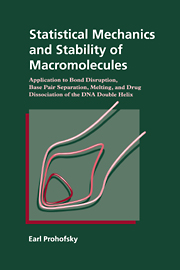 Statistical Mechanics and Stability of Macromolecules
Statistical Mechanics and Stability of Macromolecules Book contents
- Frontmatter
- Contents
- Preface
- 1 Introduction
- 2 Macromolecular stability
- 3 Lattice dynamics
- 4 Effective phonon theory
- 5 Premelting disrupted chemical bonds
- 6 Cooperative melting
- 7 Strained chemical bonds: salt and pressure effects
- 8 Bond disruption and conformation change: B to Z conformation change in DNA
- 9 Hydration effects: structural water
- 10 Helix with daunomycin intercalated: increased helix stability and daunomycin-DNA binding constant
- 11 Nonrepeating DNA
- 12 Cutting and splicing: junctions, inserts, and the replicating fork
- 13 Interaction between a helix and a single attached molecule
- 14 Energy considerations in bond opening
- Appendix 1 Helical lattice dynamics
- Appendix 2 Density matrix and effective phonon theory
- Appendix 3 Green functions
- References
- Index
Preface
Published online by Cambridge University Press: 16 September 2009
- Frontmatter
- Contents
- Preface
- 1 Introduction
- 2 Macromolecular stability
- 3 Lattice dynamics
- 4 Effective phonon theory
- 5 Premelting disrupted chemical bonds
- 6 Cooperative melting
- 7 Strained chemical bonds: salt and pressure effects
- 8 Bond disruption and conformation change: B to Z conformation change in DNA
- 9 Hydration effects: structural water
- 10 Helix with daunomycin intercalated: increased helix stability and daunomycin-DNA binding constant
- 11 Nonrepeating DNA
- 12 Cutting and splicing: junctions, inserts, and the replicating fork
- 13 Interaction between a helix and a single attached molecule
- 14 Energy considerations in bond opening
- Appendix 1 Helical lattice dynamics
- Appendix 2 Density matrix and effective phonon theory
- Appendix 3 Green functions
- References
- Index
Summary
Significant understanding of biological processes has been made by studying the dynamics of macromolecules at the microscopic level. The bulk of the researchers interested in the results are biochemists, chemists, pharmacists, and biologists. The MSPA approach developed in this book is based on methods used in condensed matter physics which are not familiar outside that discipline. The method is useful in solving long time scale problems in molecular biology that should be of interest to the biochemists etc. working in the field. This book is therefore aimed at presenting both a coherent development of the MSPA methodology and some of the background needed to understand it by persons not coming from a physics background. Biophysicists may find the results and the physics background of interest. To increase the usefulness of the book to the different readers I have, to the extent possible, concentrated on concepts and description in the main text and kept the mathematical formalism in appendices. On the other hand physicists may be interested in the way that physics methodologies have to be altered to be applied to be useful in this new situation. The complexity of biological systems is greater than that usually dealt with in condensed matter investigation and changes in approach are necessary. Physicists may also be interested in the development of a new approach to cooperative transitions that seems to work very well, particularly in large complex systems.
- Type
- Chapter
- Information
- Statistical Mechanics and Stability of MacromoleculesApplication to Bond Disruption, Base Pair Separation, Melting, and Drug Dissociation of the DNA Double Helix, pp. ix - xPublisher: Cambridge University PressPrint publication year: 1995
